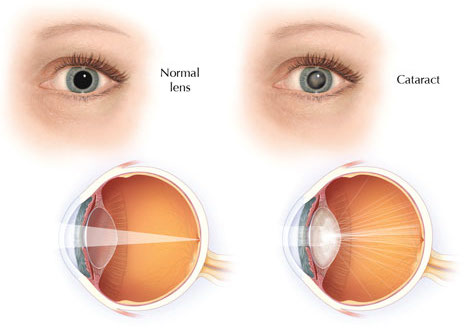Cataracts are a prevalent eye condition that can severely impact vision if not addressed in time. Often associated with aging, cataracts form when the eye’s lens becomes clouded, leading to various visual disturbances that gradually worsen. While cataracts usually develop slowly, early detection is critical to preventing significant vision loss. Unfortunately, many people dismiss the early signs, attributing them to normal aging. Early recognition of symptoms can make a substantial difference in the treatment outcome. Here are some signs to watch for so you know if cataracts are developing.
Blurry Vision
Blurry vision is one of the earliest indicators of cataracts and should not be overlooked. This symptom occurs when the eye’s lens becomes cloudy, scattering light as it enters the eye, resulting in a loss of clarity. Initially, this blurriness may only affect a small portion of the lens, leading to minimal interference with vision. As the cataract grows, the blurriness spreads, making it increasingly difficult to see details, read small print, or recognize faces. Over time, this blurriness can worsen, severely impairing your ability to perform everyday tasks. If your vision is becoming persistently blurry, it is essential to seek an eye examination to determine if cataracts are the cause.
Difficulty Seeing at Night
Causes of cataracts often make night vision particularly challenging, a symptom many overlook until it becomes a significant issue. As the lens clouds over, it reduces the amount of light reaching the retina, which is crucial for seeing in low-light conditions. This reduction in light can make it difficult to navigate at night or in dimly lit areas, and you may find driving at night increasingly hazardous. Headlights from oncoming traffic may cause intense glare, and you might also see halos around streetlights, making it harder to judge distances and see obstacles. Ignoring this symptom can lead to dangerous situations, especially when driving. If you notice that your night vision is deteriorating, it’s crucial to consult an eye specialist.
Increased Light Sensitivity
Light sensitivity, or photophobia, is another sign of cataracts that can significantly impact your daily life. This condition occurs when the lens becomes cloudy, causing light to scatter inside the eye and creating discomfort in bright environments. You may squint or shield your eyes more often when outdoors or under artificial lighting. This sensitivity can be particularly problematic when driving during the day, as sunlight reflecting off surfaces can create overwhelming glare. The discomfort from light sensitivity can interfere with your ability to enjoy outdoor activities or even comfortably work in well-lit indoor spaces. If you experience a sudden or increasing sensitivity to light, it may be time to check your eyes for cataracts.
Seeing Halos Around Lights
Halos around lights are a common and often troubling sign of cataracts many people experience as the condition progresses. This phenomenon occurs when the cloudy lens scatters light, creating rings or halos around light sources. These halos are most noticeable at night and can appear around headlights, streetlights, or even the light from a computer screen. The presence of halos can make driving at night particularly challenging, as the rings of light can obscure your vision and make it difficult to focus. This symptom can also cause discomfort in brightly lit environments, further complicating your ability to see clearly. If you start noticing halos around lights, it strongly indicates that cataracts may develop, and you should seek medical advice.
Faded or Yellowed Colors
A lesser-known but equally important sign of cataracts is a change in color perception, where colors appear faded, dull, or yellowed. This occurs because the cataract acts as a filter, altering the light that reaches the retina and affecting how you perceive colors. Whites may take on a yellowish tint, and other colors may seem less vibrant or washed out. This shift in color perception can develop gradually, making it easy to overlook until the change becomes more pronounced. Over time, this can significantly affect your ability to enjoy visual details, such as a sunset’s richness or a flower garden’s vibrancy. If you notice that colors are not as vivid as they used to be, it could be a sign that cataracts are starting to form, and you should see your eye doctor.
Frequent Changes in Prescription Glasses
Needing to update your prescription glasses more frequently than usual is a potential sign of cataracts that you should pay attention to. As cataracts progress, they can alter the eye’s refractive power, leading to rapid changes in your vision. While updating your prescription might temporarily improve your sight, the underlying issue worsens, leading to more frequent changes in your corrective lenses. This can become frustrating and costly as new glasses fail to provide lasting clarity. If your optometrist notices that your prescription needs frequent adjustments or if you find that new glasses don’t seem to help as much as expected, it’s essential to explore whether cataracts are the cause. Early detection can lead to better management and treatment outcomes.
Now That You Know
Cataracts are a leading cause of vision impairment, but early detection and treatment can prevent significant vision loss. Blurry vision, difficulty seeing at night, increased light sensitivity, seeing halos around lights, faded colors, and frequent changes in prescription glasses are all critical signs that you should not ignore. If recognized and addressed early, these symptoms can lead to timely intervention, such as cataract surgery, which can restore clear vision. Regular eye check-ups and staying informed about these warning signs can help you maintain good eye health. By being proactive, you can ensure that cataracts do not hinder your ability to enjoy life to the fullest.















